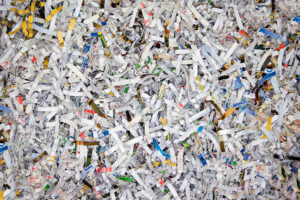Medical waste disposal is heavily regulated. It is important to understand what is involved in this process, from collection to disposal, so your office can stay compliant with regulations and avoid costly fines and potential litigation.
Collecting & Separating
The first step in the process is collecting and properly separating the medical waste that the facility has generated. This includes sharps (needles, broken glass, razors, etc) and red bag materials (IV tubing, cultures, infectious and potentially infectious materials, etc).
Sharps are to be kept in puncture-resistant sharps boxes. The boxes must be mounted upright, include a closable lid, and be leak-proof on the sides and bottom. The boxes are never to be filled more than 3/4 of the way, and they usually include a fill line reminding you of that fact.
Red bag waste is required to be placed in bags that are puncture resistant.
Containers that will be hauled off site for treatment and disposal have much more specific labeling requirements, such as complete business name, waste generator registration number, an outline of the types of contents, and more.
To ensure your compliance throughout the entire process, you should give OSHA-approved training to every single staff member that could potentially come into contact with medical waste. During this training, employees will learn what exactly constitutes medical waste, and how important it is to separate it properly.
Improper segregation of medical waste is actually a huge problem in the industry. It can result in workplace accidents, such as sharps cutting through a red bag liner and harming an employee. It can also end up costing a lot of money, especially when regular garbage is thrown into medical waste bags, because it’s management that has to pay for the removal of that improperly placed waste.
Storage & Transport
You should consult your state authorities for specific storage regulations applicable to you, but typical requirements include having a specific low-traffic area at your facility designated for the storage of medical waste. There should be refrigeration readily available, designated to hold medical waste only, in case that piece of waste requires separation.
All reusable containers (drums, dumpsters, pails, etc) should be well labeled, have a tight-fitting lid, and be kept in good working order so as not to harm the red bags or Sharps boxes they contain. There are also guidelines for washing containers after infectious waste is removed from them.
The Department of Transportation dictates how medical waste should be packaged and labeled during transportation. The department also has specific hauling licenses on transport trucks and dictates truck specifications and cleaning regulations.
Treatment
Before 1997, the common method of destroying medical waste was incineration, however due to the EPA’s Office of Air Quality Planning and Standards regulations, this practice is now almost extinct. Today, most medical waste is treated.
The various means of treating medical waste are:
- Thermal treatment, such as microwave technologies;
- Steam sterilization, such as autoclaving;
- Electropyrolysis; and
- Chemical mechanical systems, among others.
Many facilities utilize third party haulers to pick up and then treat and dispose of their medical waste. That is not the only way however. In fact, more and more facilities are opting to treat their medical waste onsite *** Add link to home page *** to help avoid hidden fees that are often associated with third party haulers.
Disposal
Once medical waste is treated properly, it can then be disposed of at municipal landfills or down sewer systems. There are state and local government regulations, so do your homework.
You should also ensure any third party haulers are also following all the regulations. Medical waste generators have a “cradle-to-grave” responsibility for their waste in the eyes of federal, state, and local authorities. This means that even if you pay a third party hauler to treat and dispose of your medical waste, you are liable for any issues that may come up.
If you choose a third party, you must ensure they are following all applicable rules that are imposed on your facility whatever state or city it may be located in.
Medical waste disposal is not a simple process. It involves several steps: collecting, separating, storing, transporting, treating, and disposal, all surrounded by a multitude of laws and regulations. There is a lot more involved in these regulations than what has been mentioned here, like additional OSHA regulations and HIPAA compliance rules for example. So always make sure to consult the relevant agencies for specifics.
One of the most violated regulations is OSHA’s requirement to have an Exposure Control Plan. If your facility doesn’t have a plan, you can face very costly fines. In fact, you can just be fined for not updating your plan every year in accordance with their strict requirements.
For Exposure Control Plan tips, please see below.










